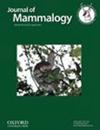Genome-wide data support recognition of an additional species of Neotropical river otter (Mammalia, Mustelidae, Lutrinae)
IF 1.5
3区 生物学
Q2 ZOOLOGY
引用次数: 0
Abstract
Cryptic biodiversity continues to be revealed worldwide, even in apparently well-known groups such as carnivorans. The Neotropical Otter (Lontra longicaudis) presents shape variation in its nose pad, a character that has been used to differentiate species in this group. Based on this, 3 subspecies are recognized: L. l. annectens (Mexico, Central America, and South America west of the Andes), L. l. enudris (Amazon and Orinoco basins), and L. l. longicaudis (Paraná basin and remaining distribution). Previous studies partially supported their distinctness based on mitochondrial DNA markers, morphometrics, and ecological niche modeling. We analyzed genome-wide nuclear markers (ultraconserved elements) of 29 L. longicaudis individuals across the species’ range to assess its population structure. Phylogenomic analysis recovered L. longicaudis as paraphyletic with robust support, with 1 clade comprising samples from Mexico and Colombia (trans-Andean populations) and another encompassing the remaining samples (cis-Andean populations), which grouped with 2 other South American species, L. felina and L. provocax. Principal component and admixture analyses strongly differentiated the 2 main L. longicaudis groups, and distinguished the Amazonian individuals from the remaining cis-Andean samples. Our results support the recognition of trans-Andean populations of L. longicaudis as a distinct otter species, which should be recognized as Lontra annectens.全基因组数据支持确认新热带河獭(哺乳纲,鼬科,鼬属)
隐蔽的生物多样性在全球范围内不断被揭示,即使是在食肉动物等众所周知的类群中也是如此。新热带水獭(Lontra longicaudis)的鼻垫形状各异,这一特征已被用来区分该类群的物种。据此,该物种被认定为 3 个亚种:l.annectens(墨西哥、中美洲和安第斯山脉以西的南美洲)、L. l. enudris(亚马逊河和奥里诺科河流域)和 L. l. longicaudis(巴拉那河流域和其余分布区)。以前的研究基于线粒体 DNA 标记、形态计量学和生态位模型,部分支持了它们的区别。我们分析了该物种分布区 29 个 L. longicaudis 个体的全基因组核标记(超保守元素),以评估其种群结构。系统发生组分析表明,L. longicaudis是一个支持率很高的旁系物种,其中一个支系包括墨西哥和哥伦比亚的样本(跨安第斯种群),另一个支系包括其余样本(顺安第斯种群),它们与另外两个南美洲物种L. felina和L. provocax同属一个支系。主成分和混杂分析强烈区分了两个主要的 L. longicaudis 群体,并将亚马逊河流域的个体与其余的顺安第斯山脉样本区分开来。我们的研究结果支持将跨安第斯地区的 L. longicaudis 种群视为一个独特的水獭物种,应将其认定为 Lontra annectens。
本文章由计算机程序翻译,如有差异,请以英文原文为准。
求助全文
约1分钟内获得全文
求助全文
来源期刊

Journal of Mammalogy
生物-动物学
CiteScore
3.30
自引率
5.90%
发文量
106
审稿时长
4-8 weeks
期刊介绍:
Papers are published on mammalian behavior, conservation, ecology, genetics, morphology, physiology, and taxonomy.
 求助内容:
求助内容: 应助结果提醒方式:
应助结果提醒方式:


